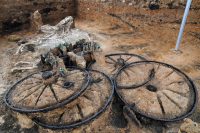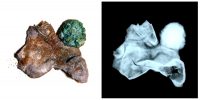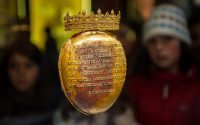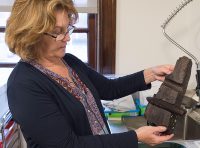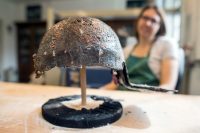British Film Institute researchers have discovered a rare cache of Technicolor silent film fragments, including flapper icon Louise Brooks dancing from her first credited movie role in The American Venus (1926). The film is lost, with only the trailer still known to be extant. This short clip of Louise Brooks is not a fragment from the movie itself. The footage appears to be a screen test of some kind, possibly a costume test.
Conservation Specialist Jane Fernandes found the fragments in the BFI National Archive in a reel of The Black Pirate (1926) that had been donated to the BFI by The Museum of Modern Art (MOMA) in 1959. A swashbuckling adventure written by and starring Douglas Fairbanks, The Black Pirate was the third feature-length film to be shot entirely in the early two-tone Technicolor technology. It is a milestone of color feature film and one of Fairbanks’ greatest performances.
The BFI restored its copy of The Black Pirate in 1970 at the behest of Douglas Fairbanks Jr., but technology has advanced by leaps and bounds since then. Fernandes was examining the original reels for a new restoration project focusing on early Technicolor when she noticed that the celluloid lead on the reel was edited together pieces of film from other movies. Louise Brooks dancing for The American Venus was accompanied by clips from The Far Cry, The Fire Brigade and Dance Madness, all from 1926.
In the same print of Black Pirate, there is also a test shot for historical drama Mona Lisa (1926) starring Hedda Hopper, the ‘Queen of the Quickies’ and legendary acerbic Hollywood gossip columnist for the LA Times, whose biting wit was recently portrayed by Judy Davis in award-winning TV series Feud. The fragment shows Hedda Hopper as Mona Lisa in repose, one assumes, about to be painted by Leonardo da Vinci. No other material from Mona Lisa is currently held by any film archive.
Other extracts from a number of early Technicolor musicals were discovered in a batch of 1950s cinema ads for a local television shop in Chingford, North East London that were donated to the BFI National Archive last year. All dating from 1929 these fragments comprise footage from Sally, which only exists in black and white, a previously lost section of Gold Diggers of Broadway, as well as short clips from Show of Shows and a trailer for On With The Show! In addition a short extract donated by one of the BFI’s curators in 2007, has now been identified as Paris (1929). […]
Potentially coming from test shots, trailers, alternative takes and outtakes these short sequences may not have appeared in the final complete films or have been used for promotional use.
The BFI has compiled the snippets in a single video and uploaded it to their YouTube channel. In a voiceover, BFI curator Bryony Dixon explains the background of the film, why it survived and its significance today. You can see Louise Brooks looking like an Erte’ figurine come to life at the 1:14 mark.


